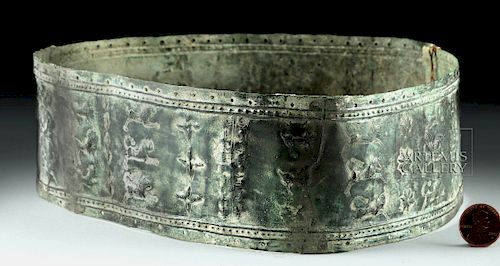Syro-Hittite Bronze Belt - Stamped Stag Hunt
Lot 123b
About Seller
Artemis Gallery
686 S Taylor Ave, Ste 106
Louisville, CO 80027
United States
Selling antiquities, ancient and ethnographic art online since 1993, Artemis Gallery specializes in Classical Antiquities (Egyptian, Greek, Roman, Near Eastern), Asian, Pre-Columbian, African / Tribal / Oceanographic art. Our extensive inventory includes pottery, stone, metal, wood, glass and textil...Read more
Estimate:
$5,000 - $7,500
Absentee vs Live bid
Two ways to bid:
- Leave a max absentee bid and the platform will bid on your behalf up to your maximum bid during the live auction.
- Bid live during the auction and your bids will be submitted real-time to the auctioneer.
Bid Increments
| Price | Bid Increment |
|---|---|
| $0 | $25 |
| $300 | $50 |
| $1,000 | $100 |
| $2,000 | $250 |
| $5,000 | $500 |
| $10,000 | $1,000 |
| $20,000 | $2,500 |
| $50,000 | $5,000 |
| $100,000 | $10,000 |
| $200,000 | $20,000 |
About Auction
By Artemis Gallery
Jun 20, 2019
Set Reminder
2019-06-20 10:00:00
2019-06-20 10:00:00
America/New_York
Bidsquare
Bidsquare : Ancient / Ethnographic From Around the World
https://www.bidsquare.com/auctions/artemis-gallery/ancient-ethnographic-from-around-the-world-4217
Around the world & back in time - be amazed at the treasures you will find. Antiquities from Egypt, Greece, Italy and the Near East, Asian, Pre-Columbian, African / Tribal / Oceanic, Native American, Spanish Colonial, Russian Icons, Fine Art, much more! All categories, all price ranges.. all legal Artemis Gallery info@artemisgallery.com
Around the world & back in time - be amazed at the treasures you will find. Antiquities from Egypt, Greece, Italy and the Near East, Asian, Pre-Columbian, African / Tribal / Oceanic, Native American, Spanish Colonial, Russian Icons, Fine Art, much more! All categories, all price ranges.. all legal Artemis Gallery info@artemisgallery.com
- Lot Description
Ancient Near East, Syro-Hittite, ca. 12th to 8th century BCE. A rare bronze belt with stamped motifs depicting a stag hunt. Stamped into the bronze are repeated images of scampering stags, ibexes, and lions. Each motif repeats three times vertically. Cross- and diamond-shaped forms, also stamped, are between each set of animals. A thin stamped border is at top and bottom, with punched, tiny holes above and below them and around the edges to allow it to be sewn to a leather backing. Similar known belts are composed of two sheets of bronze that are sewn together at one end. This example would have once had a clasping mechanism on its other end. Size: 9.25" W x 2.6" H (23.5 cm x 6.6 cm)
Hittite royalty had game enclosures set up specifically for hunting, and hunting imagery, specifically the stag hunt, was associated with religious ritual. For example, the Sphinx's Gate at Alaca Hoyuk (13th century BCE) and the Lion Gate at Malatya (early 10th century BCE) were both carved with large, monumental hunting scenes featuring the ruling elite, stags, and lions. Processions celebrating ritual hunts passed through these gates at different times of the year, including some where people paraded with standards bearing figures of stags and masked dancers reenacted hunting scenes in front of large audiences. This belt connects explicitly to that imagery and probably belonged to someone of high status, associated with the world of hunting not to survive, but instead to demonstrate their high social standing.
Provenance: private East Coast, USA collection
All items legal to buy/sell under U.S. Statute covering cultural patrimony Code 2600, CHAPTER 14, and are guaranteed to be as described or your money back.
A Certificate of Authenticity will accompany all winning bids.
We ship worldwide and handle all shipping in-house for your convenience.
#138495Repaired and restored at two points along the body. This is well done and not noticeable from the decorated front of the piece. One end of the belt is partially lost and the end is sharp. Modern copper wire has been used to hold the two ends of the belt together. Rich, deep green patina on the surface, with nicely preserved motifs.Condition
- Shipping Info
-
All shipping is handled in-house for your convenience. Your invoice from Artemis Gallery will include shipping calculation instructions. If in doubt, please inquire BEFORE bidding for estimated shipping costs for individual items.
-
- Buyer's Premium



 EUR
EUR CAD
CAD AUD
AUD GBP
GBP MXN
MXN HKD
HKD CNY
CNY MYR
MYR SEK
SEK SGD
SGD CHF
CHF THB
THB














